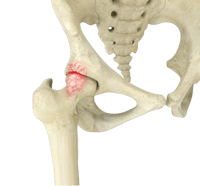Femoro Acetabular Impingement

Femoro acetabular impingement (FAI) is a condition in which the bones of the hip joint collide with one another or impinge, leading to pain and damage to anatomic structures in the hip. The damage can occur to articular cartilage (the smooth white surface of the ball and socket) or the labrum (the rim of fibrocartilage of the edge of the socket) during normal movement of the hip.
FAI is conceptualized as occurring in two ways, both of which result from abnormal bone anatomy around the hip.
CAM Impingement : Cam impingement occurs when the femoral head is not perfectly round and excess bone is present at the junction of the femoral head and neck. This excess bone on the femur contacts the labrum and rim of the acetabulum with hip flexion and internal rotation.
PINCER Impingement : Pincer impingement occurs when the acetabulum (socket) is too deep and covers too much of the femoral head. As a result, the labral cartilage is pinched between the bones in certain hip positions. The Pincer form of impingement may also be caused when the hip socket is abnormally angled backwards (retroverted) causing abnormal impact between the femoral head and the rim of the acetabulum.
Most diagnoses of FAI include a combination of the Cam and Pincer forms – termed “mixed-type FAI”.
Symptoms of FAI
Symptoms of femoro acetabular impingement can include the following:
- Groin pain associated with hip activity
- Complaints of pain in the front, side or back of the hip
- Pain may be described as a dull ache or sharp pain
- Patients may complain of a locking, clicking, or catching sensation in the hip
- Pain often occurs to the inner hip or groin area after prolonged sitting or walking
- Difficulty walking uphill
- Restricted hip movement
Diagnosis
Hip conditions should be evaluated by an orthopaedic hip surgeon for proper diagnosis and treatment. Dr. Driscoll will take a thorough medical history, examine the hips, and may perform diagnostic tests including X-Rays and MRI. Injection of local anesthetic and sometimes corticosteroid are also sometimes helpful in confirming the diagnosis.
Treatment Options
Non-surgical management of FAI will probably not change the underlying abnormal biomechanics of the hip causing the FAI but may offer pain relief and improved mobility
Non - surgical treatment measures
- Rest
- Activity Modification and Limitations
- Anti-inflammatory Medications
Surgical treatment
- Hip arthroscopy to repair femoro acetabular impingement is indicated when conservative treatment measures fail to provide relief to the patient.
